Save water, energy, time — and money — with these ten eco-friendly fall yard tips
The average American’s environmental footprint has increased exponentially over the past 100 years, with America currently having the highest per capita water consumption in the world. The average African uses about 5 gallons of water per day, an average European uses 50 gallons per day, and the average American uses over 100. In addition, chemicals, personal care products, pharmaceuticals, and other toxins have been detected in some of our water supply resources. There are many simple, cost-effective methods of reducing our ecological footprint and of improving the environment in which we all live — and it starts right in our own backyard.
1 Direct downspouts onto lawn or garden
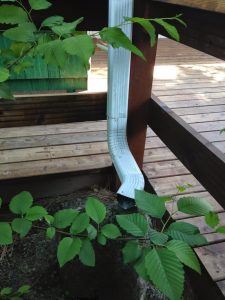 Stormwater has become a major environmental concern, as it carries pollution, chemicals, and bacterial contamination into our waterways. One of the easiest ways to prevent stormwater from entering storm drains is to direct downspouts onto grassy areas or gardens. Downspouts should never drain onto impervious surfaces such as driveways or walkways where stormwater flows unfiltered into storm drains or waterways. Plants and soil act as a filter for stormwater so that it is cleaner when it enters our water supply.
Stormwater has become a major environmental concern, as it carries pollution, chemicals, and bacterial contamination into our waterways. One of the easiest ways to prevent stormwater from entering storm drains is to direct downspouts onto grassy areas or gardens. Downspouts should never drain onto impervious surfaces such as driveways or walkways where stormwater flows unfiltered into storm drains or waterways. Plants and soil act as a filter for stormwater so that it is cleaner when it enters our water supply.
2 Install a rain barrel
Rain barrels capture rainwater from gutters and downspouts for reuse in gardens and lawns, preventing unfiltered pollutants from entering our waterways. Installed easily, rain barrels come in an assortment of shapes and sizes, can be inexpensively built from readily obtained materials, and can even be decorative. A rain barrel is also a fun project for kids, and introduces them to the concepts of conservation and reuse. Note: rain barrels should not be allowed to freeze, as they could suffer damage or even break. Empty them and put them into storage when winter arrives.
3 Clean gutters
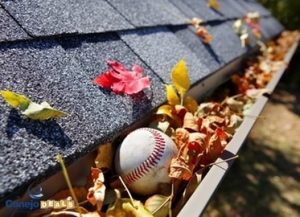 One of the easiest ways to prevent stormwater runoff AND save your roof and siding is to clean the gutters on your home. Utilizing a ladder or a service, remove all dead leaves and debris from gutters and ensure that water flows freely from gutters to downspouts. If your gutters clog frequently or if your home is in a heavily wooded area, consider installing gutter guards.
One of the easiest ways to prevent stormwater runoff AND save your roof and siding is to clean the gutters on your home. Utilizing a ladder or a service, remove all dead leaves and debris from gutters and ensure that water flows freely from gutters to downspouts. If your gutters clog frequently or if your home is in a heavily wooded area, consider installing gutter guards.
4 Sweep driveways and walkways
Never use a hose to wash down driveways, walkways, and sidewalks! Hosing down these surfaces wastes water and also pushes pollution into storm drains and waterways. Instead, sweep away dirt and debris and dispose of it properly so that pollution doesn’t enter drains or our water supply.
5 Aerate your lawn
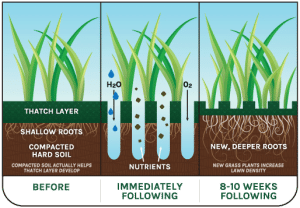
Over time, lawns become compacted from use, preventing water and nutrients from reaching roots. Aerating removes small plugs of soil from the lawn, loosening the soil and allowing oxyten, nutrients, and water to more easily permeate the lawn. Aeration improves the health of soil and allows grass roots to grow more deeply, resulting in a more vibrant lawn. Consider sharing the cost of aerator rental from your local hardware store with a neighbor.
6 Apply natural fertilizer
Contrary to what most lawn maintenance companies profess, lawns only need to be fertilized once per year, ideally in the fall. Avoid using chemical or synthetic fertilizers as they contain water-soluble nitrogen, which dissolves during rain or lawn watering and can run into our water supply. Instead, opt for natural fertilizers, which typically contain insoluble nitrogen that is released slowly over time onto the lawn. Natural fertilizer stays in the lawn for a longer time period, providing better feeding, and prevents over-fertilizing and subsequent burning. Even better, the easiest, most affordable natural fertilizer can be found right in your own backyard…
7 Start composting
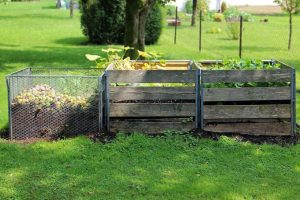 Rather than being bagged and hauled off to already overflowing landfills, grass clippings, dead leaves, and other organic yard waste can be turned into organic fertilizer rich in nutrients. Simply shred the waste using clippers or a mulcher, and then add it to a compost bin. Compost bins can be quickly constructed with a few items from the hardware store or can be bought pre-assembled. Green waste, such as grass clippings, is rich in nitrogen, whereas brown waste provides carbon energy for the organisms responsible for doing the decomposing. Be sure to add relatively equal amounts of both for the best possible results. Add water to the pile until it is just moist enough to wring a few drops of water from the waste, and then let it do its work! Add kitchen vegetable scraps and yard waste to the pile, keep it moist, and turn it once a month. By spring, you will have all natural, nutrient rich fertilizer — for free. Note: meat, ashes, pet waste, and pressure treated wood should never be composted.
Rather than being bagged and hauled off to already overflowing landfills, grass clippings, dead leaves, and other organic yard waste can be turned into organic fertilizer rich in nutrients. Simply shred the waste using clippers or a mulcher, and then add it to a compost bin. Compost bins can be quickly constructed with a few items from the hardware store or can be bought pre-assembled. Green waste, such as grass clippings, is rich in nitrogen, whereas brown waste provides carbon energy for the organisms responsible for doing the decomposing. Be sure to add relatively equal amounts of both for the best possible results. Add water to the pile until it is just moist enough to wring a few drops of water from the waste, and then let it do its work! Add kitchen vegetable scraps and yard waste to the pile, keep it moist, and turn it once a month. By spring, you will have all natural, nutrient rich fertilizer — for free. Note: meat, ashes, pet waste, and pressure treated wood should never be composted.
8 Overseed
Fall is the best time to add grass seed to your lawn. Overseeding inhibits weed growth, improves lawn appearance, and increases drought tolerance. When overseeding, use native grass and groundcover seeds that require less maintenance and water and provide higher stress tolerance than traditional grass seed. Utilize a seed spreader to ensure uniform seeding.
9 Update outdoor lighting
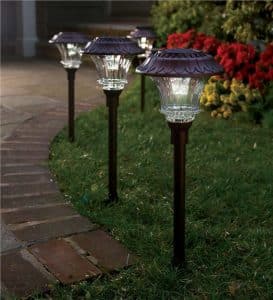
Shorter days are upon us, which means longer nights — and outdoor lighting that stays on for an extended period of time. Replace outdated incandescent bulbs with LED or fluorscent bulbs to save energy and money. Also, install automatic shut-offs or timers on outdoor lights to avoid running lights when they aren’t needed. Enthusiastic environmentalists can consider purchasing and installing solar lights. Solar lights are energy efficient and eco-friendly, wire-free, automatically turn on at dusk and off at dawn, produce a warm and inviting glow, and are a snap to install. Solar lights are available in every shape and size and can be used for walkways, entry areas, driveways, sheds, pools, patios, and even holiday decorating.
10 Perform an exterior house check
To save water and energy this winter, be sure to perform an exterior house check this fall. Examine all windows and doors for gaps and cracks, and repair any areas that allow heat to escape. Also, remove all hoses from outdoor spigots and be sure the water is turned off. If you have a pool, winterize it properly to prevent any damage, and be sure to install a quality pool cover to minimize water evaporation. Since the average pool holds about 25,000 gallons of water, avoiding the need to refill the pool in the spring is an important step in household water conservation.
